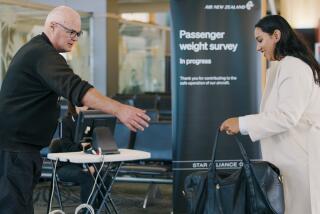Can ‘augmented reality’ help you check the size of your carry-on bag?
- Share via
When most passengers want to see if their carry-on bag is small enough to be allowed in the cabin, they either measure the bag’s dimensions at home or try to cram the bag into a measuring rack when they arrive at the terminal.
KLM, the flag carrier of the Netherlands, is now letting passengers use what the airline calls “augmented reality” to check the size of the bags.
A new feature on the KLM smartphone app lets passengers aim their smartphone camera at their luggage to see “virtual luggage” sitting next to their real bag. Using the app, travelers can move the virtual luggage on top of the image of the real bag to see which is bigger.
“By offering this service, we are placing the needs of our customers first,” Pieter Groeneveld, senior vice president of digital for Air France - KLM, said in a statement. “We also continue to be pioneers of innovation in our passengers’ best interests.”
Carry-on bag sizes have been a source of frustration for fliers in recent months.
In June, Alaska Airlines and Virgin America shrank the permissible dimensions of carry-on bags by 32%. The luggage that travelers can bring into the cabin can be no bigger than 22 inches long, 14 inches high and 9 inches wide. Those are the same maximum dimensions for carry-on bags on Delta, United and American, which set an informal industry standard given their positions as top carriers. There are no federal regulations governing carry-on bags.
American Airlines recently began to allow fliers who book basic economy seats to bring aboard one personal item and one carry-on bag without charge. Until that rule changed on Sept. 5, basic economy passengers were allowed only a personal item that fit under the seat, but couldn’t use the overhead bins for luggage.
To read more about the travel and tourism industries, follow @hugomartin on Twitter.
More to Read
Inside the business of entertainment
The Wide Shot brings you news, analysis and insights on everything from streaming wars to production — and what it all means for the future.
You may occasionally receive promotional content from the Los Angeles Times.










